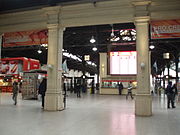| Retiro Belgrano | |
|---|---|
| Commuter rail | |
 | |
| General information | |
| Location | Avenida Ramos Mejía 1430 Buenos Aires Argentina |
| Coordinates | 34°35′26″S 58°22′34″W / 34.59056°S 58.37611°W / -34.59056; -58.37611 |
| Owned by | Government of Argentina |
| Operated by | Ferrovías |
| Line(s) | Belgrano Norte |
| Platforms | 6 |
| Connections | Subte (under construction: Retiro Mitre Retiro San Martín Bus terminus |
| Other information | |
| Fare zone | Retiro, Buenos Aires |
| History | |
| Opened | 1912; 112 years ago (1912) |
| National Historic Monument of Argentina | |
| Designated | 2021 |
Retiro-Belgrano, or simply Retiro, is one of the six large mainline railway station termini in Buenos Aires, Argentina. Located in the neighborhood of Retiro, it serves as terminal station for the Belgrano Norte Line that runs local trains to the northern suburbs of the Buenos Aires metropolitan area. It also functions as terminal station for the national cargo train General Belgrano Railway.
Built in 1912, its Beaux-Arts design makes it one of the most recognizable landmarks of french neoclassicism in the country. The terminal is the fourth-busiest train station in Argentina.
Overview
Retiro Belgrano is the terminus for the General Belgrano Railway and is adjacent to the Retiro bus station (Terminal de Omnibus), the principal long-distance bus terminal in Buenos Aires, the Retiro Mitre station of Mitre Railway, and the Retiro San Martín station of the San Martín Railway. The complex is accessible by the C line of the Buenos Aires Metro system and by numerous local public bus services.
The station will also be accessible by both Line E and Line H of the metro once their extensions are complete.
Retiro Belgrano has three entrances, the main one on Ramos Mejía avenue, another next to the main entrance (on the same avenue) and a lateral one (on Padre Mujica street, at the east).
History
The building was built by the British Córdoba Central Railway that originally connected the cities of Rosario and Córdoba until in 1903 the Government allowed the company to extend its network to Buenos Aires, from north to south. In 1906 trains reached Villa Rosa in Pilar Partido and finally arriving in Buenos Aires in 1912. The terminal station, designed by architects Faure Dujarric (Louis Faure-Dujarric) and Robert Prentice, was remodeled and enlarged in 1914. One floor and a dome with a clock were added to the original construction. The building style has remained to present days.
In 2011 the station was remodeled, repairing the external masonry, facade and dome.
In May 2021, the station was declared National Historic Monument, along with other terminal stations such as Once, Constitución, and Federico Lacroze.
Historic operators
| Operator | Period |
|---|---|
| 1912–1948 | |
| 1948–1991 | |
| 1991–1994 | |
| 1994–present |
- Notes
- Temporary operator prior to the privatization of commuter rail services.
Gallery
References
- "Historia de las estaciones terminales Retiro", Arcón de Buenos Aires
- "Renovación y puesta en valor de estaciones terminales de ferrocarriles", Secretaría de Transporte
- Declararon Monumento Histórico Nacional a las estaciones de tren de Constitución, Once, Lacroze y Retiro on Infobae, 10 May 2021
- MONUMENTOS HISTÓRICOS NACIONALES - Decreto 315/2021 on Boletín Oficial, 7 May 2021
| Railway terminals in Buenos Aires | |
|---|---|
| Active | |
| Closed | |
| Rail transport in Argentina | |
| Railway stations in Argentina | |||||
|---|---|---|---|---|---|
| Buenos Aires |
| ||||
| Córdoba | |||||
| Mendoza | |||||
| Neuquén | |||||
| Río Negro | |||||
| Santa Fe | |||||
| Tucumán | |||||





